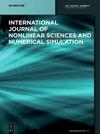Framing the hydrothermal significance of water-based hybrid nanofluid flow over a revolving disk
IF 1.5
4区 工程技术
Q2 ENGINEERING, MULTIDISCIPLINARY
International Journal of Nonlinear Sciences and Numerical Simulation
Pub Date : 2022-10-17
DOI:10.1515/ijnsns-2022-0137
引用次数: 1
Abstract
Abstract In this article, the authors have presented the MHD hybrid nanoliquid flow comprised of CuO and Ag nanoparticles (nps) over a rotating disk under the effects of thermophoresis, Brownian motion, activation energy, heat source and chemical reaction. The flow is considered over a spinning disc with convective conditions. The proposed model is solved with the help of HAM. The convergence of the HAM is also shown in order to verify the convergence of the modeled problem. The effects of embedded parameters on the velocity, energy and mass profiles of the magnetohydrodynamic flow of hybrid nanoliquid are shown with the help of Figures. Also, the effects of embedded parameters on skin friction, heat and mass transfer rate are calculated with the help of Tables. The results showed that the velocity and energy profiles are augmented with the increasing solid volume fraction. The increasing magnetic parameter reduces both the radial and tangential velocities of the hybrid nanofluid flow. The increasing effects of heat source, thermophoresis and Brownian motion factors on energy profiles are found. The increasing influence of thermophoresis and activation energy factors on concentration profile of the hybrid nanofluid flow is found, while the increasing Brownian motion, chemical reaction and Schmidt number reduce the concentration profile.构建旋转圆盘上水基混合纳米流体流动的水热意义
摘要在本文中,作者提出了在热泳、布朗运动、活化能、热源和化学反应的影响下,由CuO和Ag纳米颗粒(nps)组成的MHD混合纳米液体在旋转圆盘上的流动。考虑了在对流条件下旋转圆盘上的流动。在HAM的帮助下对所提出的模型进行了求解。为了验证建模问题的收敛性,还展示了HAM的收敛性。嵌入参数对混合纳米液体磁流体动力学流动的速度、能量和质量分布的影响如图所示。此外,还借助表格计算了嵌入参数对表面摩擦、传热和传质速率的影响。结果表明,随着固体体积分数的增加,速度和能量分布都有所增加。增加的磁性参数降低了混合纳米流体流的径向和切向速度。发现了热源、热泳和布朗运动因子对能量分布的增加效应。热泳和活化能因子对混合纳米流体流的浓度分布的影响越来越大,而布朗运动、化学反应和施密特数的增加使浓度分布减小。
本文章由计算机程序翻译,如有差异,请以英文原文为准。
求助全文
约1分钟内获得全文
求助全文
来源期刊
CiteScore
2.80
自引率
6.70%
发文量
117
审稿时长
13.7 months
期刊介绍:
The International Journal of Nonlinear Sciences and Numerical Simulation publishes original papers on all subjects relevant to nonlinear sciences and numerical simulation. The journal is directed at Researchers in Nonlinear Sciences, Engineers, and Computational Scientists, Economists, and others, who either study the nature of nonlinear problems or conduct numerical simulations of nonlinear problems.

 求助内容:
求助内容: 应助结果提醒方式:
应助结果提醒方式:


